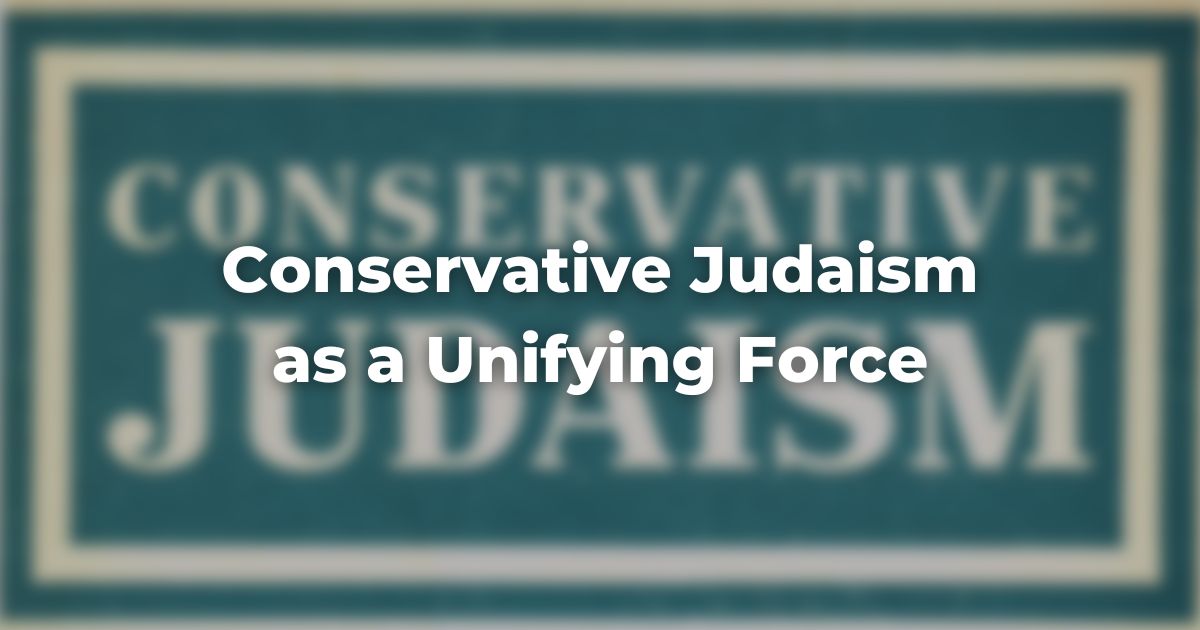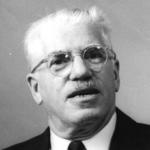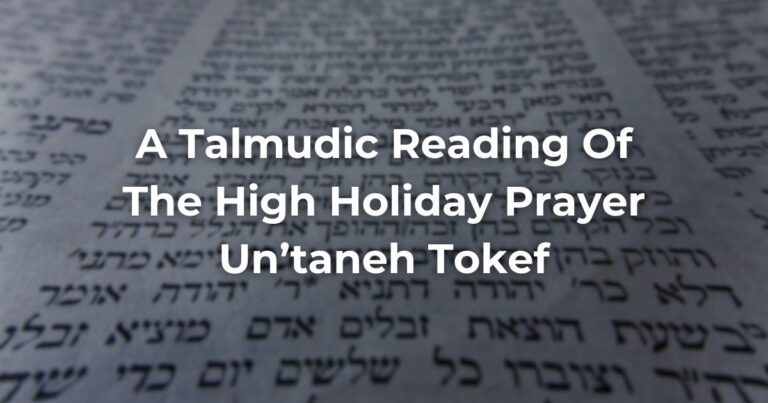This is a part of our “Core Conservative Judaism Ideas” series and believe this piece offers something substantial to the understanding of Judaism and Conservative Judaism.
This article was published in the Conservative Judaism academic journal, a publication of the Conservative Movement that ran from 1945-2014 that reflected the some of the many voices of the movement, and was recently relaunched as Masorti Journal.
This piece was written by Rabbi Max Arzt z”l in in 1949. The language and style may reflect the time it was written.
The piece has been reformatted for readability and edited for length. The full article with footnotes is available for those who wish to read it. Headings added by the editor.
Editor’s Summary of Main Points
- Conservative Judaism was originally formed in reaction and protest to “iconoclastic tendencies of radical reform” Judaism in the late 1800s as a coalition of traditionally minded Jews.
- It began as “historical Judaism” referring to the concept of a “traditional Judaism built on the broad basis of science and history” and that “Judaism is not a closed system but a tradition with historic continuity and vitality developing and growing as it faces the challenge of a new era.” This “historical school” was never intended to be a new form of Judaism. “It was to foster normative Judaism on the American continent.”
- Early Conservative Judaism rejected “rigid uniformity of belief and practice” because “since life is too complex and personal temperaments and situations vary.” And that “a higher unity transcends their differences without suppressing them.”
- Despite the reality that many people who do not observe mitzvot, “We should each aspire valiantly toward the maximum of observance. It is, however, not given to us to sit in judgment over our fellow man in matters “bein adam lamakom.” More specifically, people “should avoid the arrogant sanctimoniousness which categorically refuses to understand the circumstances that condition other people’s religious life. On the other hand, those who feel that there are extenuating circumstances which preclude their conformance with some aspects of our tradition should not expect the ideal pattern of tradition to be adjusted to their measure.” Tolerance should be given to those more and less observant of us equally.
- There are places in Halakhah that require action, “I refer to the injustices resulting from the arrested development of the Halakha in matters of marriage and divorce. Here the fundamental social structure of our people is involved.” Failure to take action constitutes an inexcusable delay in the amelioration of human tragedy” and that acting is in service of Jews everywhere.
- “The fluidity of Conservative Judaism’s position on religious observance should be a stimulus rather than a deterrent to united action in behalf of more widespread personal observance. The main patterns of religious piety are abidingly valid. They are the vitamins of a zestful and meaningful religious life.”
- In a world full of -isms, each individual “suffers from spiritual homesickness and needs anchorage for his soul in a living tradition which can lead him to walk in the light of God’s presence.”
Conservative Judaism as a Unifying Force (1949)
Conservative Judaism has been subjected to criticism by many of its affiliates because of the flexible and fluctuating nature of its body of doctrine and practice. The demand for concise definition has of late become more vocal than ever before. It is requested that before long the diversity of ritual conduct in Conservative congregations should give way to a uniformity and unanimity of religious policy and procedure. Then, at last, claim the precisionists, we will have a ready unequivocal answer to the question:
What is Conservative Judaism?
…
The Origins of the Movement
We can clarify our position and yet avoid a retreat into sectarianism by a consideration of the origins of our movement and the motives that prompted its establishment. Conservative Judaism in America arose as a protest against the iconoclastic tendencies of radical reform. The founders of Conservative Judaism constituted a “united front” against those who repudiated Jewish tradition and who would date the genesis of Judaism from the French Revolution.
Accentuating the universalistic overtones of the Prophets, the radical reformers abrogated the authority of the TalmudReferring to one of two collections, the Jerusalem and Babylonian Talmuds, edited in the 6th century, that contains hundreds of years of commentary, discussion, and exploration of the ideas in the Mishnah. One could describe it as Mishnah + Gemara = Talmud Read more and virtually obliterated the pattern of religious life that flowed from it. Their antinomian emphasis tended to make Judaism invisible in the home, and their misdirected patriotism led them to excise Zion from the Prayerbook and to dehebraize public worship and Jewish education. They began to tamper with the Jewish calendar, even venturing to imply that Sunday might be welcomed with the Sabbath psalm: “mizmor shir leyom Ha Shabbat.”
Alarmed because these teachings and tendencies were gathering momentum, men of orthodox conviction, such as Sabato Morais and H. Perira Mendes, made common cause with liberals, such as Marcus Jastrow, Alexander Kohut, and Benjamin Szold. They rose to the defense of “historical Judaism.”
Though aware of the differences in doctrine and practice which prevailed among them, they were supremely conscious of the need to avert the threatened dissolution of traditional Judaism. Somehow they all sensed that Judaism in America could not remain impervious to the currents of modern thought and the conclusions of scientific research.
They knew that Judaism in America was destined to undergo changes necessitated by the American scene. But they wanted Judaism in America to retain its organic identity with its historic tradition.
At first, assured by Isaac M. Wise and his associates that they too fixed their gaze on this objective, the protagonists of the historical school strove to maintain the religious unity of American Jews. Isaac Leeser, in his personal life a rigid traditionalist, attended the abortive Rabbinical Conference held in Cleveland in 1849 at which Isaac M. Wise was elected chairman.
Sabato Morais served on the Board of Examiners of the Hebrew Union College and Benjamin Szold delivered the address at the first graduation exercises of the College. In this address Szold pointed out that unanimity of religious thought and practice leads to atrophy and petrification and that diversity is a sign of vitality and creativity (American Hebrew, July 20, 1883).
The “conservatives” seceded only after the Pittsburgh platform of 1885 repudiated Jewish tradition, officially discarded the hope for the restoration of Palestine and decreed the obsolescence of the main body of Jewish religious practice. They could no longer in all conscience remain allied with those who in their desire for change were ready to amputate from Jewish life such vital elements as Hebrew, the traditional Jewish Sabbath day, and the dietary laws.
When Morais and Mendes joined Jastrow, Kohut, and Szold, and other liberals in founding the Jewish Theological Seminary of America, they did not enter upon a mere pact of convenience. They believed that common endeavor in behalf of Jewish scholarship and a strong bias in favor of Jewish tradition would enable the conservative school to evince a unity that would permit and yet transcend the diversion of outlook and practice prevailing among them.
They could not surrender the future of Judaism in America to extremists of the left who negated tradition and to extremists of the right whose monolithic attitude threatened to drive traditionalists of liberal tendencies into isolation or into the camp of reform. Morais in discussing preliminary plans for the establishment of a Seminary to foster traditional Judaism, first suggested that it be named “The Orthodox Seminary.” He was readily convinced by Kohut to desist from this suggestion and the name The Jewish Theological Seminary of America was unanimously adopted. The historical school was not to be a new sect. It was to foster normative Judaism on the American continent.
Rejecting Sectarianism
The aversion to sectarianism was in even larger measure characteristic of Solomon Schechter. He said, “The Directors of the Institution, by terming it The Jewish Theological Seminary of America have distinctly shown their intention of avoiding sectarianism, for it is an especial American feature that no preference is given to any denomination or sect or theological richtung. They are all alike welcome” (Seminary Addresses, p. 48). Thus Schechter envisioned the emergence of a form of traditional Judaism built on the broad basis of science and history, “which can hope to become a force and bring about that reconciliation among the parties to which every well-wisher of Israel is looking forward” (ibid., p. 74).
Schechter’s vision, also shared by his successor Cyrus Adler, in spired the further development of the Seminary in the past decade into a University of Judaism. This fruition of the Seminary’s basic interest in the unity of American Jews was formulated and clarified by Dr. Mordecai M. Kaplan in an epochal address delivered at the 35th anniversary of the Teachers Institute in 1945.
Under Dr. Finkelstein’s leadership, the Seminary’s expanded program of academic activity and public education has transcended all factional loyalties in American Judaism. The Jewish Museum and the Eternal Light program have been an inspiration to all American Jews and indeed to countless Americans of other faiths. They are bringing within the orbit of Judaism, musicians, artists, men of letters and others who have hitherto stood on the periphery of Jewish life.
In the University of Judaism recently established on the West Coast, as a branch of the Seminary, Jews of all types of opinion and affiliation are members of the Board of Overseers of this new spiritual and cultural center. Firm in its loyalty to tradition, the Seminary has never overlooked its all embracing function as an exponent of and spokesman for the spiritual unity of American Jewry.
Establishing the United Synagogue
Likewise, in bringing into being the United Synagogue of America, Schechter aimed to establish a functioning organization “broad enough to admit the cooperation of all synagogues that are devoted to the conservation of traditional Judaism whether they call themselves Conservative or Orthodox.’’ He furthermore stated “we regard it as a sacred duty that all such forces unite, irrespective of the differences which otherwise divide them… to conserve all the positive elements which they have in common” (1913 Address, p. 3).
Thus he envisioned the possibility of the harmonious cooperation of congregations of varying degrees of conformance to tradition, provided that they were all fired by a strong desire to conserve and further the traditions to which they were all committed. Schechter delineated the wide area of common action which provided an ample consensus of agree ment for the varying types of congregations that responded to his call in behalf of the United Synagogue of America.
The preamble to the Constitution of the United Synagogue indicates the basis of such cooperative endeavor:
“The advancement of the cause of Judaism in America and the maintenance of Jewish tradition in its historic continuity; to assert and establish loyalty to the TorahRefers to the first five books of the Hebrew Bible, the Tanakh, also called the Five Books of Moses, Pentateuch or the Hebrew equivalent, Humash. This is also called the Written Torah. The term may also refer to teachings that expound on Jewish tradition. Read more in its historic exposition; to further the observance of the Sabbath and the Dietary Laws; to preserve in the service the reference to Israel’s past and the hopes for Israel’s restoration; to maintain the traditional character of the liturgy, with Hebrew as the language of prayer; to foster Jewish religious life in the home as expressed in traditional observances; to encourage the establishment of Jewish religious schools, in the curricula of which the study of the Hebrew language and literature shall be given a prominent place, both as the key to the true understanding of Judaism, and as a bond holding scattered communities of Israel throughout the world. It shall be the aim of the United Synagogue while not endorsing the innovations introduced by any of its constituents to embrace all elements essentially loyal to traditional Judaism and in sympathy with the purposes outlined above.”
This preamble, written in 1913, testifies to the vision and states manship of its author, Solomon Schechter. It implies that Judaism is not a closed system but a tradition with historic continuity and vitality developing and growing as it faces the challenge of a new era.
In the emancipation era, Jews were catapulted from the ghetto into the life and culture of the modern scientific and industrial civilization In the face of such a cyclonic transformation, the otherwise gradual process of development was greatly accelerated.
In traveling at break neck speed, one must hold fast as one turns a sharp corner. The preamble therefore sets forth the vital traditions to which American Jews must cling as Judaism makes the transition from the straits of the ghetto to the broad places of modern life.
Traditional Observances
The Sabbath, the dietary laws and the traditional observances in the home are to be furthered. The Hebrew language must be fostered as the bond of unity among Jews in all lands and the key to sound Jewish learning.
Hence, it must ever remain the predominant language of Jewish worship and the vehicle of an intensive Jewish education. The preamble affirms that the prayerbook must continue to express our historic association with the Holy Land and our hopes for its restoration.
Specific in underscoring these fundamentals, the preamble avoids further explicitness. It does not envision a rigid uniformity of belief and practice. Total conformance in matters of religion may have been possible in pre-democratic times and lands in which the social and intellectual climate induced unquestioned obedience.
In the climate of democracy one cannot expect uniform obeisance to a regimen of religious expression, since life is too complex and personal temperaments and situations vary. In a democratic society, united endeavor among individuals and groups is possible only when a higher unity transcends their differences without suppressing them.
In such a voluntary society, sectarianism and schismatic fragmentation are the inevitable results of imperial insistence on rigid particularizations of noble objectives. Unity can be attained only in the midst of diversity. The United Synagogue aims to include within its orbit all Jews who are essentially loyal to the fundamental traditions of Judaism. It invites the affiliation and cooperation of all whose sincere desire it is to strengthen loyalty to the Torah in its historic exposition.
Unity in Diversity
In thus providing for unity in the midst of inevitable diversity, the preamble takes cognizance of the varied practices existing among its founding congregations. Some had introduced innovations such as family pews and the organ.
These innovations were not outlawed, for by common consent such matters were left to the collective conscience of each congregation and to the guidance of its rabbi. Nor are the innovations endorsed, as such endorsement would have com mitted the more traditionally minded rabbis and congregations to the approval of that with which they were not in accord.
Hence the preamble concludes with the following statement: “It shall be the aim of the United Synagogue while not endorsing the innovations introduced by any of its constituent bodies, to embrace all elements essentially loyal to traditional Judaism and in sympathy with the purposes outlined above.”
In the course of a few decades such innovations as family pews and ceremonies of confirmation or Bas Mitzvah for girls have become the norm in almost conservative congregations and in many “orthodox” congregations. Life and tested experience have confirmed that which our generation has found to be beneficial to the strengthening of Judaism in our age and country.
Other innovations such as the playing of the organ have not won such wide acceptance, perhaps because it still remains to be proved that the organ evokes a heightened devotional mood in Jewish worship. However, congregations using the organ are welcome in the ranks of conservative Judaism, if they endorse the major objectives of the United Synagogue.
In underscoring the maintenance of Jewish traditions, conservative Judaism avoids the dehydrated liberalism and the religious colorlessness resulting from a nihilistic disavowal of tradition. At the same time, it has wisely resisted the temptation to draw sharp lines of distinction which always lead to fanaticism, intolerance and divisiveness.
In its aftermath, World War II produced many tired liberals who yearn for dogmatic definitiveness. Averse to the old orthodoxy, they seek to define a new orthodoxy based on their particular brand of diversity. It is less perplexing to be specific and definite.
Then one enjoys the luxury of being able to state precisely where he stands and where others should stand on matters of religious belief and behavior. But as we have indicated above, such exactness leads to splinter divisions, and, therefore, militates against cooperative endeavor.
Conservative Judaism has chosen the far more vulnerable alternative of accentuating the unity of American Israel under the banner of our historic tradition and of inviting the cooperation of all who are animated by love and reverence for that tradition.
In affirming the principle of unity in diversity, which in recent years has been so convincingly expounded by Dr. Mordecai M. Kaplan, conservative Judaism places the accent on unity. Its hope is to inspire Jews to a voluntary ordering of their lives in accordance with the fundamental norms of our tradition.
The growing movement for intensifying the Hebraic character and content of religious education will help to perpetuate the pattern of congregational worship and procedure. In their collective religious life, congregations evince a strong presumption in favor of traditional patterns. This is even true of latter day reform congregations which have been profoundly influenced by Conservative Judaism.
Personal Piety
More complicated and more chaotic is the status of personal piety within the ranks of Conservative and also Orthodox Judaism. Here there is an absymal distance between the Halakha and the actual life of the people. Personal observance of the Sabbath, Kashrut, and other essentials of Judaism is on the decline. In many communities personal conformance to the Halakha has almost reached the vanishing point.
There is one heartening aspect to this distressing situation. The widespread disregard of the basic sanctities of Jewish life is no longer due to cynical defiance. It is due to indifference, ignorance, and neglect. A vigorous program of mass education and activation would arouse our people from their state of spiritual lethargy.
The case for such Sabbath “prohibitions’’ as refraining from mundane occupations, from shopping, from mowing the lawn, card playing, etc., is unanswerable. Most religious-minded Jews will readily be convinced (though not so easily persuaded to change their lives accordingly) that Sabbath attendance at public worship, daily prayer, the kindling of Sabbath candles, and the chanting of Kiddush and Zemirot are, for Jews, indispensable ingredients of a zestful religious life.
Their reconsideration of the major claims of the Halakha on their spiritual life will confirm the Psalmist’s experience “I have considered my ways and turned my feet to Thy testimonies” (Psalms 119:59).
Some observances such as Kashrut and the major home observances are, in the main, accessible to all. Others are not equally accessible to all people. The opportunities for personal religious observance and the degree of sacrifice entailed vary with the economic situation of the individual and with other compulsions of his personal situation. No code, not even a revised code, can conceivably take into account the many exigencies and complexities of modern life.
Consistent Halakhic conformance is not within equal reach of all persons even in so fundamental and so unchallenged an institution as the Sabbath.
All religiously minded Jews agree that the ideal Sabbath is one of total abstention from mundane labors. But alas, only a small minority achieve this most desirable and most essential objective, so fundamental to Jewish life. More than in any previous age, Jewish tradition is abundantly observed only by those who heroically forfeit momentary material and secular satisfactions.
We should each aspire valiantly toward the maximum of observance. It is, however, not given to us to sit in judgment over our fellow man in matters “bein adam lamakom.”
We cannot ordain the sacrifices which each person must make in behalf of tradition since personal circumstances vary considerably. Sincere and persistent conformists can find their reward in a benign peace of mind and soul and in a heightened awareness of God’s beneficent presence. But they should avoid the arrogant sanctimoniousness which categorically refuses to understand the circumstances that condition other people’s religious life.
On the other hand, those who feel that there are extenuating circumstances which preclude their conformance with some aspects of our tradition should not expect the ideal pattern of tradition to be adjusted to their measure. Thus the person who, residing a considerable distance from a synagogue rides to the synagogue, should not demand an official diminution of the Sabbath ideal by a blanket easement of the prohibition against riding. He should realize that it is still a highly desirable goal to avoid traveling on the Sabbath thus staying close to hearth and home, and to seek that refreshment of soul which comes with the leisurely gait and with freedom from the hustle and bustle of vehicular mobility.
His present circumstances may preclude his attainment of this goal, but circumstances may change and full Sabbath observance may yet come within his grasp.
Because circumstances and personal situations differ so radically in our complex society, we shall have to learn and teach a twin type of tolerance: tolerance toward those who observe more than our optimum of personal piety, and tolerance toward those who do not attain our degree of religious observance.
The former usually arouse in us a sense of guilt hence we resent their extra measure of piety. The less observant induce in us a belligerent and fanatical self-righteousness. We shall have to blend our religiosity with understanding and humility.
The Living Halakha
Conservative Judaism should accentuate the living Halakha. Certain Halakhic prohibitions, some with strong Biblical sanction, such as shaving and shaatnez, have become obsolescent even among other wise meticulously loyal traditionalists.
The temper of modern life has made aspects of the tradition inoperative. The collective conscience of the loyal elements in Catholic Israel no longer reacts to these “violations” as manifestations of wilful disregard of the Law or as indicative of religious unconcern.
In dealing with such areas of obsolescence it is wise to practice the eloquence of silence prescribed by the rabbis “Even as it is a mitzvah to exhort the people concerning that which they will obey, so it is a mitzvah not to exhort them concerning that which they will not obey (j. Terum Ch. 5 end). The discreet silence of orthodox rabbis on such matters registers their agreement with this principle.
There are however, situations where the Law must be adjusted by authoritative remedial action. I refer to the injustices resulting from the arrested development of the Halakha in matters of marriage and divorce. Here the fundamental social structure of our people is involved. Failure to take action constitutes an inexcusable delay in the amelioration of human tragedy.
Our Law Committee should commission specialists in Halakhic studies to formulate an Halakhically reasoned re-interpretation of these laws and then submit the proposal to other rabbinic groups in traditional Judaism. Should these groups, after a period of time (six months or at most a year), fail to respond with the ratification of our proposal or with a more satisfactory solution of the problem, we need no longer hesitate to implement our decision.
By utilizing proper channels of communication we can inform Kelal Yisroel of the urgency of the problem and of the caution we exercised. Our action will then win overwhelming public approbation and respect.
The fluidity of Conservative Judaism’s position on religious observance should be a stimulus rather than a deterrent to united action in behalf of more widespread personal observance. The main patterns of religious piety are abidingly valid. They are the vitamins of a zestful and meaningful religious life. The United Synagogue should plan and carry out a nationwide educational endeavor calling on our congregants to renew their covenant with the Torah by intro ducing into their lives and homes the highest optimum of religious observance available to them.
Practices which have fallen into desuetude even among observant American Jews, should not be stressed. But all that is vital and relevant should be dramatically expounded and given the widest possible dissemination. The opportunity for the revitalization of religious life is unprecedented.
The establishment of the State of Israel has alerted the religious awareness of American Jews. They are now more receptive to Judaism because they no longer suffer from a sense of collective inferiority. The primacy of religion and the synagogue is being recognized even by those who formerly equated Jewish loyalty solely with philanthropy, defense activities and Zionist propaganda.
The twentieth century Jew like his fellow men of other faiths has become disillusioned with the pseudo-religions of positivism, pragmatism, and communism— idolatries which have proven to be broken cisterns which hold no water. He suffers from spiritual homesickness and needs anchorage for his soul in a living tradition which can lead him to walk in the light of God’s presence.
Though organized Conservative Judaism comprises only a fraction of American Jewry, it can have a powerful appeal to masses of our people.
Its realistic and reverential attitude to tradition is animated by a profound concern for Jewish unity under the banner of tradition. The experience of chaplains in the armed forces revealed that the young American Jew prefers our via media.
There are unmistakable signs that American Jewry is receptive to ideals which prompted the establishment of the Conservative movement. Ours is then the opportunity to reunite the House of Israel, to teach Judaism as a Torat Hayim, and to restore the Torah to our people and our people to the Torah.
Adapted from Tradition and Change and the Conservative Judaism journal.
Author
-

Rabbi Max Arzt z"l (d. August 31, 1975) was the vice chancellor of the Jewish Theological Seminary of America, was Israel Goldstein Professor of Practical Theology. After his ordination by the seminary in 1921, he was rabbi of Temple Beth El in Stamford, Conn., and, from 1924 to 1939, rabbi of Temple Israel in Scranton, Pa. In 1939, Rabbi Arzt came to the seminary as director of field activities and associate professor of practical theology. He was named vice chancellor in 1951 and Israel Goldstein Professor in 1962. A former president of the Rabbinical Assembly of America, Dr. Arzt was a United States delegate to the North Atlantic Treaty Organization Congress in London in 1959 and a charter member of the advisory council of the International Movement for Atlantic Union. He was the author of “Justice and Mercy: A Commentary on the Liturgy of the New Year and the Day of Atonement” and a contributing editor of the magazine Judaism. Dr. Arzt was also chairman of the Joint Prayer Book Commission of the United Synagogue of America and the Rabbinical Assembly. (Edited from his obituary, NY Times)
View all posts






